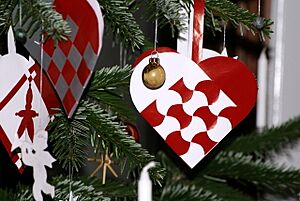Pleated Christmas hearts facts for kids
Pleated Christmas hearts (called Julehjerte in Danish) are special decorations. People in Denmark, Norway, and northern Germany often make them. They are a popular craft, especially around Christmas. These hearts are usually hung on Christmas trees or used to decorate homes during the holidays.
Contents
History of Pleated Christmas Hearts
The exact start of making paper hearts is not fully known. However, we do know some interesting facts about their history.
Early Hearts and Hans Christian Andersen
The oldest known pleated Christmas heart was made in 1860. It was created by the famous Danish author, Hans Christian Andersen. You might know him from his fairy tales like "The Little Mermaid" or "The Ugly Duckling."
Andersen's heart did not have a handle. This means it probably wasn't used as a Christmas tree decoration. Today, this special heart can be seen at the Hans Christian Andersen Museum in Odense, Denmark. We know that Andersen did make other decorations for Christmas trees. Before paper hearts, similar decorations were made from woven baskets.
Spreading the Tradition
The first guide on how to make pleated Christmas hearts appeared in 1871. It was in a Danish magazine called Nordisk Husflidstidende. The oldest pleated Christmas heart that still exists today is from 1873. You can find it at the National Museum of Norway in Oslo.
It took about 40 more years for these hearts to become widely popular. The first picture showing a Christmas tree decorated with pleated hearts is from 1901. This picture was taken at a Danish manor house called Søllestedgaard.
Hearts in Kindergartens
Around 1910, kindergartens in Denmark started using pleated Christmas hearts. Children would make them from shiny paper. This activity helped children in many ways. It encouraged their creativity and taught them patience. It also helped them improve their fine motor skills, which are important for tasks like writing and drawing.


